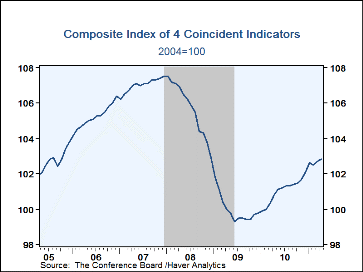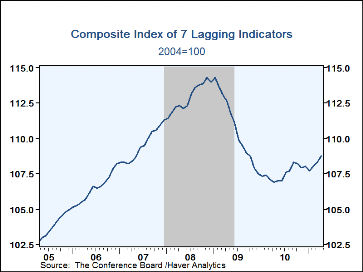 Global| May 20 2011
Global| May 20 2011U.S. Leading Economic Indicators Decline Unexpectedly
by:Tom Moeller
|in:Economy in Brief
Summary
The Conference Board reported that its Leading Economic Indicators Index unexpectedly declined 0.3% in April after an upwardly revised 0.7% March increase, originally reported at 0.4%. Consensus expectations were for a 0.1% uptick [...]
 The Conference Board reported that its Leading Economic Indicators
Index unexpectedly declined 0.3% in April after an upwardly revised 0.7%
March increase, originally reported at 0.4%. Consensus expectations were
for a 0.1% uptick during last month. The latest was the first decline
since last June. It helped reduced three-month growth in the series to 5.4%
(AR) which was down from its early-2010 high of 10.8%.
The Conference Board reported that its Leading Economic Indicators
Index unexpectedly declined 0.3% in April after an upwardly revised 0.7%
March increase, originally reported at 0.4%. Consensus expectations were
for a 0.1% uptick during last month. The latest was the first decline
since last June. It helped reduced three-month growth in the series to 5.4%
(AR) which was down from its early-2010 high of 10.8%.
The breadth of increase among the components, measured by the 1-month diffusion index, fell to 35%, down from its 80% peak last month. Higher initial claims for jobless insurance, lower (quicker) vendor performance, lower building permits and shorter weekly hours-worked had the largest negative effects on the index. These were offset by a steeper interest rate yield curve, higher consumer expectations and higher stock prices.
The index of coincident indicators ticked 0.1% higher in April after an unrevised 0.2% March increase. The three-month annualized rate of change was 0.8%, down from its January high of 4.4%. Three of the four component series contributed to the April increase.
The lagging indicator index rose 0.5% in April, the fourth increase in the last five months. Strength was led by higher C&I loans and a longer average duration of unemployment. The ratio of coincident-to-lagging indicators, which tends to "lead" the "leaders" fell for the third consecutive month to 94.5%.
The Conference Board figures are available in Haver's BCI database; the components are available there and most are also in USECON. The expectations figure is the AS1REPNA database. Visit the Conference Board's site for coverage of leading indicator series from around the world.
| Business Cycle Indicators(%) | Apr | Mar | Feb | Y/Y | 2010 | 2009 | 2008 |
|---|---|---|---|---|---|---|---|
| Leading | -0.3 | 0.7 | 0.9 | 5.0 | 7.8 | 0.3 | -3.1 |
| Coincident | 0.1 | 0.2 | -0.1 | 2.0 | 1.1 | -5.4 | -1.3 |
| Lagging | 0.5 | 0.3 | 0.3 | 1.8 | -2.9 | -1.9 | 3.1 |
Tom Moeller
AuthorMore in Author Profile »Prior to joining Haver Analytics in 2000, Mr. Moeller worked as the Economist at Chancellor Capital Management from 1985 to 1999. There, he developed comprehensive economic forecasts and interpreted economic data for equity and fixed income portfolio managers. Also at Chancellor, Mr. Moeller worked as an equity analyst and was responsible for researching and rating companies in the economically sensitive automobile and housing industries for investment in Chancellor’s equity portfolio. Prior to joining Chancellor, Mr. Moeller was an Economist at Citibank from 1979 to 1984. He also analyzed pricing behavior in the metals industry for the Council on Wage and Price Stability in Washington, D.C. In 1999, Mr. Moeller received the award for most accurate forecast from the Forecasters' Club of New York. From 1990 to 1992 he was President of the New York Association for Business Economists. Mr. Moeller earned an M.B.A. in Finance from Fordham University, where he graduated in 1987. He holds a Bachelor of Arts in Economics from George Washington University.








